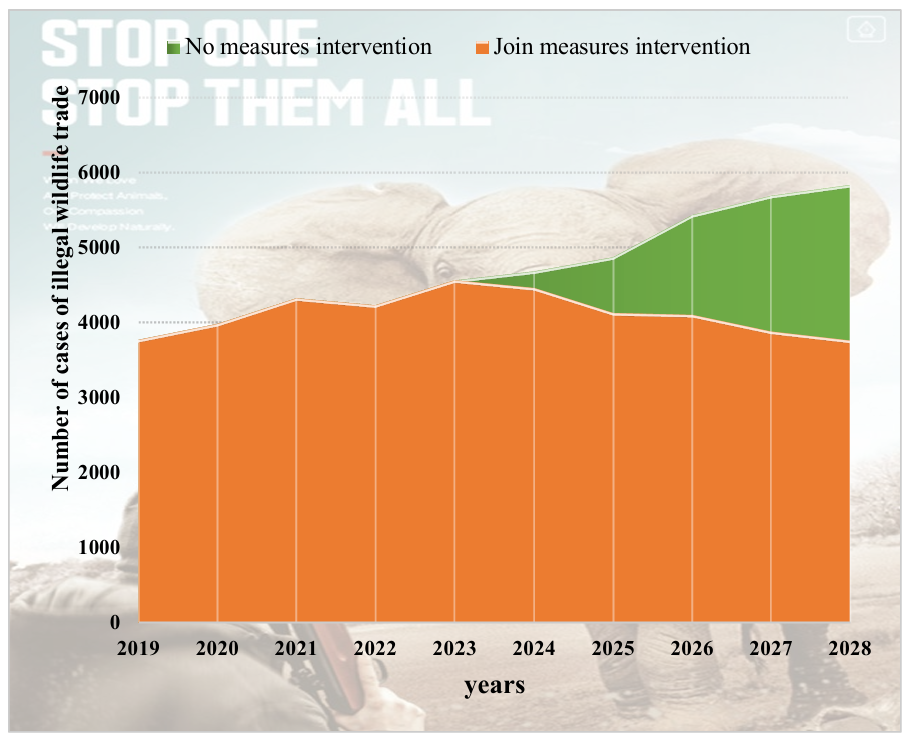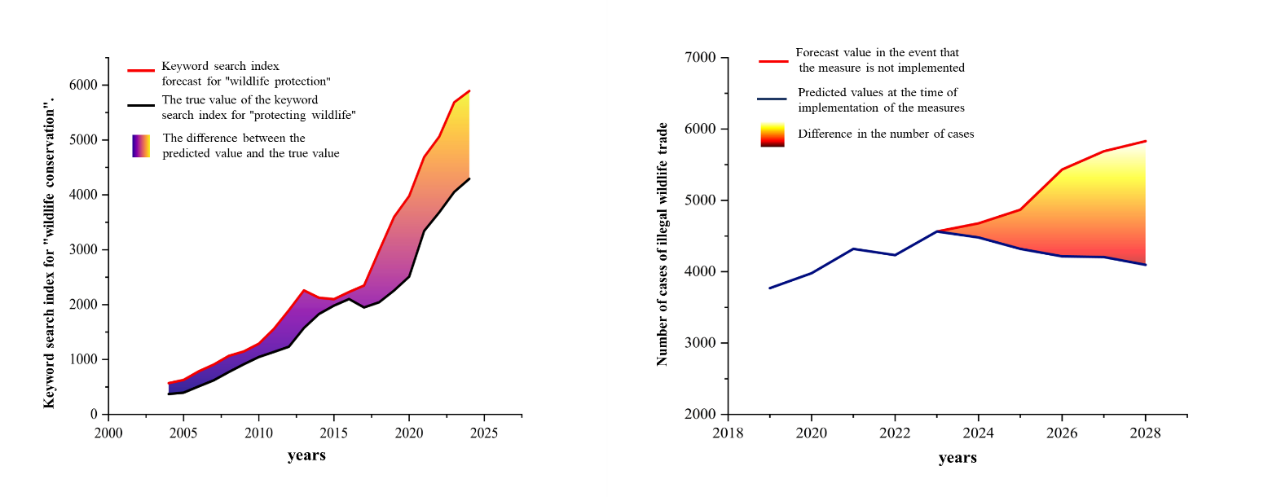1.Introduction
From 1999 to 2019, a staggering number of wildlife species have been illegally trafficked around the world [1]. Therefore, it is urgent to protect wild animals and reduce the illegal trade of wild animals. Based on a thorough analysis of the data [2], we have gained insight into the effective measure countries are taking to combat the illegal wildlife trade. In addition, we identified three specific key measures: strengthening law enforcement and oversight, raising public awareness and education, and strengthening scientific and technological testing. Our goal is to provide predictive data to demonstrate the effectiveness of these three measures in reducing illegal wildlife trade, and real data to show that such measures are an ideal way to solve the problem of illegal wildlife trade.
2.Methods
2.1.BP neural network prediction
The first measure is to expand the scope and improve the efficiency of law enforcement. The assumption that the number of countries cooperating with WWF increases by 5% each year is a precondition for making the projections. In this scheme, BP neural network is used to process data, which is a multi-layer feedforward network and uses gradient search method to minimize the mean square error in the training process [3]. However, one limitation of the BP neural network is that it can get trapped in local optimal solutions due to the initial weights being artificially set or randomly generated. To address this issue, we have innovatively integrated the particle swarm optimization algorithm. This combination allows us to optimize the initial weights and thresholds of the BP neural network, enabling us to find the most optimal values for these parameters[4]. By doing so, we can enhance the performance and effectiveness of the BP neural network in achieving accurate and reliable results.
2.1.1.Particle Swarm Optimization
The Particle Swarm Optimization is a group intelligent optimization algorithm, which is inspired by the behavior of biological groups such as birds or fish groups. It finds the optimal solution by simulating the collaboration and competition between individuals in the group[5].
The position of the particle represents the weight and threshold of the BP neural network. For the i-th particle, its position update formula at time t+1 is:
\( {x_{i}}(t+1)={x_{i}}(t)+{ν_{i}}(t+1)\ \ \ (1) \)
where\( {x_{i}}(t+1) \)is the position of the i-th particle at time t, and\( {ν_{i}}(t+1) \)is the speed of the i-th particle at time t+1.
2.1.2.Particle Velocity Update
The speed of a particle determines the change amplitude and direction of its position. For the i-th particle, its speed update formula at time t+1 is:
\( {ν_{i}}(t+1)=w{ν_{i}}(t)+{c_{1}}{r_{1}}({P_{best,i}}-{x_{i}}(t))+{c_{2}}{r_{2}}({G_{best}}-{x_{i}}(t))\ \ \ (2) \)
where w is an inertial weight, control the searches of the particles, c1 and c2 are learning factor, which is used to regulate the speed of Gbest movement of particles to the optimal position of the individual. r1 and r2 are random numbers of the [0, 1] interval, which are used to increase the randomness of search; Pbest, i is the optimal position found by the first particle so far; Gbest is the best position found by all particles so far.
2.2.Improved SIR Model
We developed a differential equation infectious disease model to predict changes in wildlife conservation awareness and education levels over a five-year period. We modified it to fit the characteristics of propaganda and communication. In this context, the concept of "infection" in our model represents the spread of public awareness and acceptance of wildlife protection through the process of effective communication and publicity efforts.
To quantify the extent of wildlife education and advocacy, we use the public's awareness of wildlife as a metric. This can be measured by the search index, which is the number of searches for keywords related to wildlife conservation in each browser.
2.2.1.Define the model composition
S (Susceptible): People who have not received publicity and education, that is, people who have not yet known wildlife protection.
I (Infected): People who have received publicity and education, that is, people who have realized the importance of the protection of wild animals.
R (Recovered): People who continue to participate in the protection operations not only accept publicity, but also actively participate in wild animal protection.
2.2.2.Model parameter
β (Transmission Rate): The propaganda and communication rate indicate that people who have not accepted the propaganda have become the rate of accepting the public.
γ (Recovery Rate): The rate of transition from receiving advocacy to continuing participation in conservation action.
N: Total Population, assumption as a constant.
We can get the following relationship:
\( N=S+I+R\ \ \ (3) \)
The change rate of the infected person (S):
\( \frac{dS}{dt}=-\frac{βSI}{N}\ \ \ (4) \)
The change rate of infection (I):
\( \frac{dI}{dt}=\frac{βSI}{N}-rI\ \ \ (5) \)
The change rate of rehabilitation (R):
\( \frac{dR}{dt}=rI\ \ \ (6) \)
2.3.Multi-objective optimization model
With the advancement of science and technology, satellite technology has gradually become an important means to protect wildlife. Drawing on the high-precision monitoring and protection of wildlife implemented by China's Beidou satellite system, we propose the third measure -to reduce illegal wild animal trade by launching satellites. We have established a linear planning model to minimize the number of illegal wildlife trade in the 5th year through a reasonable number of satellites distributing the number of satellites every year. This model assumes that the use of satellites can effectively monitor and protect wildlife and reduce illegal wild animals. The number of trade and the launch of more satellites will increase the ability and probability of monitoring and cracking down on illegal trade.
2.3.1.Decision Variable
Let\( {x_{i}} \)be the number of positioning satellites occurring in year i, where i = 1, 2, 3, 4, 5. Assuming that the annual input of positioning satellites reduces the amount of illegal wildlife trade by a certain percentage, the objective is to minimize the amount of illegal wildlife trade over a five-year period. Let the amount of illegal wildlife trade in year 5 be T5.
2.3.2.Objective Function
Because we need to minimize the number of illegal wildlife trade cases in the fifth year, So the objective function is:
\( f(x)=min{({T_{5}})}\ \ \ (7) \)
2.3.3.Restrictive Condition
From the above analysis we derive the constraints as:
\( s.t.=\begin{cases} \begin{array}{c} 0≤{x_{i}}≤30,∀x=1,2,3,4,5 \\ {T_{i+1}}={T_{i}}(1-k{x_{i}}) \end{array} \end{cases}\ \ \ (8) \)
3.Results
3.1.BP neural network prediction results
Through the above process, the Particle Swarm Optimization continuously updates the position of each particle to find the optimal value and threshold of the minimum error function.
By projecting the effect of strengthening law enforcement and supervision to reduce illegal wildlife trade, we get the following predictions:

Figure 1: Measures 1 predictive results comparison
It can be seen from Fig. 1 that starting from 2023, the number of cooperative countries with an increase of %5 each year, that is, continuously increases law enforcement can effectively reduce the number of illegal wildlife trade. The number of illegal wildlife trade cases dropped from 4,563 cases before the implementation of the measure to 3,684 cases, a decrease of about 15.07 %. It is in line with the purpose of WWF.
3.2.SIR results
After using MATLAB to solve and predict with neural network, the result is shown in Fig. 6:

(a) The true and predicted values of the (b) The difference between the number of cases
keyword search index for "wildlife protection" when the measure is implemented and when the measure is not implemented
Figure 2: Measures 2 predictive results comparison
In Fig. 2(a), we collected the search index data for the keyword "wildlife conservation" from mainstream search engines (such as Google, Microsoft, Baidu, etc.) over a 20-year period from 2004 to 2024. We then utilized the SIR model to predict the expected values. Assuming that we have strengthened publicity and education efforts since 2004, the predicted values indicate an improvement in the search index. This suggests that an increasing number of citizens have started to pay attention to wildlife protection, reflecting the positive impact of enhanced advocacy and education. In Fig. 2(b), we used the predicted data from the SIR model as input to forecast the number of illegal wildlife trade cases within five years after implementing measures to strengthen citizen awareness and education. The dark blue curve in Fig. 2(b) represents this prediction. Our analysis concludes that increased advocacy and education of citizens can contribute to a reduction in the number of illegal wildlife trade cases. Specifically, the number of cases decreased from 4,563 before implementing these measures to 3,970, representing a decrease of approximately 10.17%. This aligns with the objectives of organizations like WWF, aiming to combat illegal wildlife trade.
Overall, these findings highlight the potential effectiveness of strengthening publicity and education campaigns in mitigating illegal wildlife trade and fostering greater public engagement in wildlife conservation efforts.
3.3.Projected Results
Upon calculation, we can solve for the following result:
\( k=-0.0185,{T_{5}}=3875\ \ \ (9) \)

(a) Linear regression fitting (b) Comparison of the number of cases before and after the implementation of the measures
Figure 3: Measures 3 predictive results comparison
Through the fitting, we conclude that the number of satellites that need to be deployed is 132, and the number of illegal wildlife trade cases will drop from 4,563 before the implementation to 3,875 in the fifth year, a decrease of about 15.08%.
Obviously, it can be concluded that the application of satellite positioning, satellite remote sensing and other related technologies can reduce illegal wildlife trade to a certain extent. This method is actually the protection of wildlife through high-tech. On the one hand, real-time satellite detection can obtain the status information of animal populations in a timely manner, so as to protect them from natural disasters and diseases. On the other hand, satellite positioning technology can track the location information of animal populations or individual animals in real time to prevent them from being taken away by thieves. The application of this technology can better protect wildlife, which also in line with WWF's mission.
4.Conclusion
This study addresses the pressing issue of illegal wildlife trade worldwide by proposing three data-driven measures aimed at enhancing wildlife protection efforts. Through the establishment of a BP neural network optimized by the particle swarm optimization algorithm, an improved SIR model, and a linear programming model, we have evaluated the effectiveness of expanding law enforcement, raising public awareness and education, and utilizing satellite technology for high-precision monitoring. The results indicate significant reductions in the number of illegal wildlife trade cases over the next five years: Measure 1, focusing on enhancing law enforcement, is projected to reduce the number of cases by 15.07%. Measure 2, which emphasizes public awareness and education, is expected to decrease cases by 10.17%. Measure 3, involving the deployment of satellites, is anticipated to lower the number of cases by 15.08%. These findings not only validate the effectiveness of the proposed strategies but also provide actionable insights for law enforcement agencies and conservation organizations. Future research will explore the synergistic effects of these measures and their implementation across different regions, aiming to develop comprehensive and tailored approaches to combat illegal wildlife trade and preserve biodiversity globally.
References
[1]. Feng L, Liao W J, Hu J H. Towards a more sustainable human–animal relationship: the legal protection of wildlife in China[J]. Sustainability, 2019, 11(11): 3112.
[2]. Yang R, Ford B J, Tambe M, et al. Adaptive resource allocation for wildlife protection against illegal poachers[C]. Aamas. 2014: 453-460.
[3]. Dong X A, Xu B J. Tele communication traffic forecasting based on BP neural network trained by PSO[J]. Journal of Central South University, 2011, 42(1): 24-25.
[4]. Wu S B, Cao W H. Tuning model for microwave filter by using improved back‐propagation neural network based on gauss kernel clustering[J]. International Journal of RF and Microwave Computer‐Aided Engineering, 2019, 29(8): 21787.
[5]. Dhiman G, Garg M, Nagar A, et al. A novel algorithm for global optimization: rat swarm optimizer[J]. Journal of Ambient Intelligence and Humanized Computing, 2021, 12: 8457-8482.
Cite this article
Che,J. (2025). Data-Driven Strategies for Combating Illegal Wildlife Trade: A Predictive Analysis. Theoretical and Natural Science,83,91-96.
Data availability
The datasets used and/or analyzed during the current study will be available from the authors upon reasonable request.
Disclaimer/Publisher's Note
The statements, opinions and data contained in all publications are solely those of the individual author(s) and contributor(s) and not of EWA Publishing and/or the editor(s). EWA Publishing and/or the editor(s) disclaim responsibility for any injury to people or property resulting from any ideas, methods, instructions or products referred to in the content.
About volume
Volume title: Proceedings of the 4th International Conference on Computing Innovation and Applied Physics
© 2024 by the author(s). Licensee EWA Publishing, Oxford, UK. This article is an open access article distributed under the terms and
conditions of the Creative Commons Attribution (CC BY) license. Authors who
publish this series agree to the following terms:
1. Authors retain copyright and grant the series right of first publication with the work simultaneously licensed under a Creative Commons
Attribution License that allows others to share the work with an acknowledgment of the work's authorship and initial publication in this
series.
2. Authors are able to enter into separate, additional contractual arrangements for the non-exclusive distribution of the series's published
version of the work (e.g., post it to an institutional repository or publish it in a book), with an acknowledgment of its initial
publication in this series.
3. Authors are permitted and encouraged to post their work online (e.g., in institutional repositories or on their website) prior to and
during the submission process, as it can lead to productive exchanges, as well as earlier and greater citation of published work (See
Open access policy for details).
References
[1]. Feng L, Liao W J, Hu J H. Towards a more sustainable human–animal relationship: the legal protection of wildlife in China[J]. Sustainability, 2019, 11(11): 3112.
[2]. Yang R, Ford B J, Tambe M, et al. Adaptive resource allocation for wildlife protection against illegal poachers[C]. Aamas. 2014: 453-460.
[3]. Dong X A, Xu B J. Tele communication traffic forecasting based on BP neural network trained by PSO[J]. Journal of Central South University, 2011, 42(1): 24-25.
[4]. Wu S B, Cao W H. Tuning model for microwave filter by using improved back‐propagation neural network based on gauss kernel clustering[J]. International Journal of RF and Microwave Computer‐Aided Engineering, 2019, 29(8): 21787.
[5]. Dhiman G, Garg M, Nagar A, et al. A novel algorithm for global optimization: rat swarm optimizer[J]. Journal of Ambient Intelligence and Humanized Computing, 2021, 12: 8457-8482.









